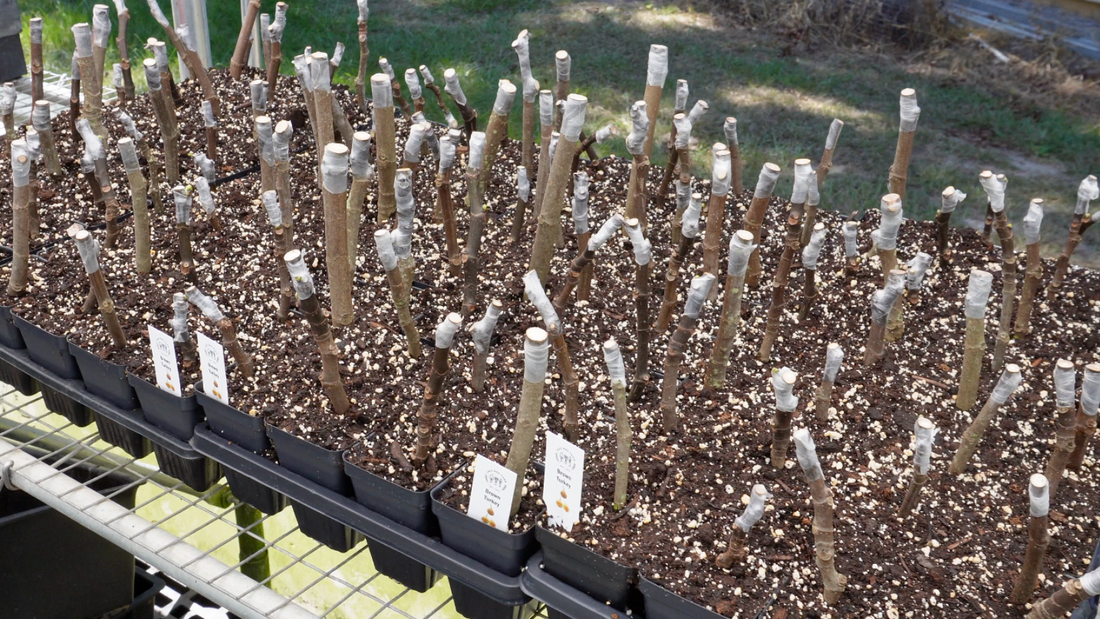Earlier this year while visiting an online fig forum, I noticed one commenter complaining about some fig cuttings that he had purchased from someone online. His complaint was that these fig cuttings were still green and would not store well for him over the winter. I was curious as to why someone would purchase cuttings that they weren't going to start immediately, but that's none of my business. It did get me thinking though, and so I thought I'd use this blog to explain how we choose fig cuttings for propagation.
New Wood vs. Old Wood on Fig Trees
"New wood," or growth from the current year, is pretty easy to identify on a fig tree. It usually has more of a brown color than the older wood on the fig tree. "Old wood" is growth from previous years and usually has a gray color.
I've grown fig trees from old wood cuttings, but I prefer to take my cuttings from new wood. They always seem to root faster and grow more vigorous than fig cuttings taken from old wood. In the long run I can't tell any difference in the production of a fig tree started from new wood vs old wood, but it does increase the speed of propagation of fig trees in our greenhouse.

Green Fig Cuttings
"Green" fig cuttings are taken from parts of the tree that haven't lignified yet. This is the tissue at the end of branches that is still a little tender and spongy. As the tree keeps growing, this growth will eventually harden and turn brown instead of green.
Green cuttings will propagate extremely fast. This is because they're full of life and cells that are actively dividing. We can often times get green cuttings to form new buds and leaves in just a few weeks.
However, green cuttings don't store very well. If you're taking cuttings and plan to store them in the fridge for a few months before propagating them, green cuttings aren't going to be good idea. We put all our cuttings in soil within a few hours of taking them, so it works well for us. But green cuttings aren't going to work well for everyone.

When to Take Fig Cuttings
I like to take cuttings before our fig trees go dormant in the winter. This is because they root faster and are more likely to give us a nice fig tree that we can ship the following spring. But if you're not growing fig trees to sell, you might want to wait until the tree goes dormant.
Cutting fig trees that are still growing has some downsides. You'll sacrifice some of that new growth because you're cutting it before it becomes lignified. If you live in a southern climate, you may also be sacrificing some fall fig production which is always nice to have.
Ideally you'd want to wait until the fig tree has gone completely dormant and has lost its leaves in the late fall or early winter months. This usually happens after your first hard freeze of the fall or winter. At this point your fig tree is done growing for the year, and you won't have to worry about sacrificing growth or production by cutting them.

Choosing a Good Fig Cutting
Assuming you've got plenty of options on the tree you're wanting to propagate, I'd definitely recommend taking a cutting from the wood on the tree that has formed in the last year. If you've never propagated figs, you might want to steer clear of green cuttings for the time being. Although they start fast, they can dry faster which means frequent watering or misting is necessary until they root.
The thickness of the fig cutting you take will depend on what you have available on the tree, but I'd recommend cutting a branch at least 1/4" to 1/2" thick. Thicker cuttings tend to produce stronger root systems in the early stages of propagation. I've propagated plenty of tiny twigs over the years, but the thicker, robust cuttings are always faster and easier.
For beginner fig propagation, the cutting should be at least 8" long. I can often times get 4-5" cuttings to do great, but it takes a bit more finesse. If you've got plenty of new wood on the tree, take a longer cutting. Try to find a cutting that has at least 3-4 nodes, if not more. The more nodes on the cutting, the more buds you'll have a chance at forming.
Start More Fig Trees Than You Need!
The more you propagate fig cuttings, the better you'll get and your percentages will increase each year. But in the beginning, it's not unrealistic to get success percentages around 50%. This means that half the cuttings you start will actually form a viable fig tree.
We propagate thousands of fig cuttings every year and I've never gotten a 100% success rate on any variety, but I can get in the high 80s or 90th percentile. If you're a beginner, start twice as many cuttings as you think you'll need. If you're wanting to plant 2 new trees, start at least four cuttings. If they all four make it, this just means you'll have some to share with family and friends!

